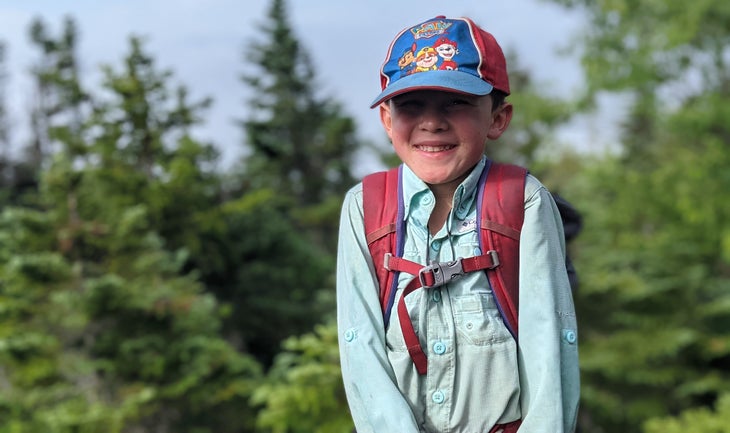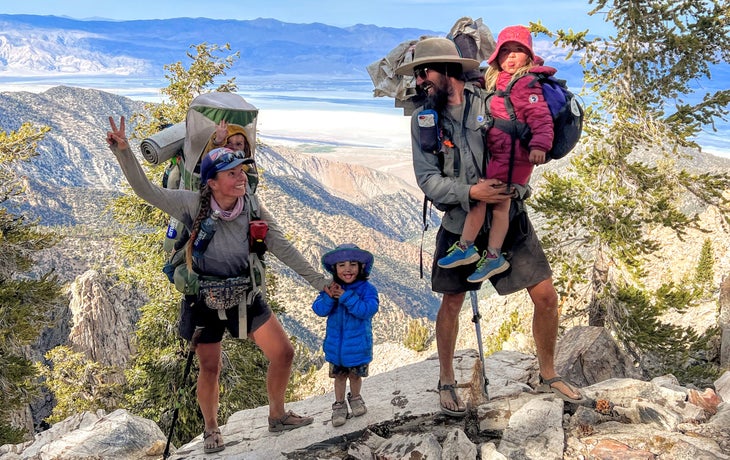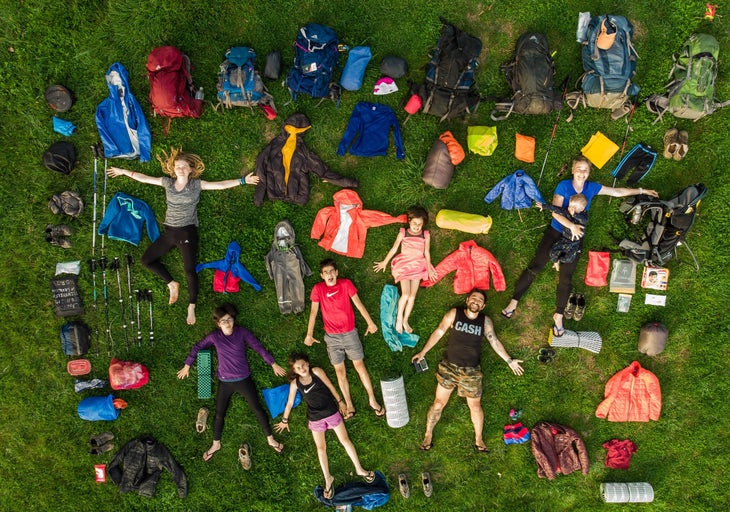Ben Crawford thought that if he and his wife, Kami, ever had more than two children, they wouldn’t be able to hike the Appalachian Trail. But after having six kids, the Crawfords took their entire family on the 2,200 miles from Georgia to Maine in 2018, becoming the largest family to ever thru-hike the iconic path.
“I had never seen anyone do it, so I bought into that myth: the more kids you have, you can’t do this shit,” says Ben, sitting beside Kami in the courtyard of the collection of old houses they’ve steadily been buying in Bellevue, Kentucky. “That’s a lie.”
In early May, , both 42, became an when the entire family—including their youngest, six-year-old Rainier—completed Cincinnati’s in nine hours. On social media, the Crawfords were both accused of child abuse and praised for their free-range parenting. Child Protective Services visited, just as they had in 2018, when the family crossed from North Carolina to Tennessee on the AT after sleeping through a blizzard in a bathroom. (They were cleared in both cases.) “That prepared us for all this,” Kami says. “It brings you together.”
“I’m not trying to make a case for why all parents should go outdoors with their kids. I’ve just heard a lot of arguments for why indoors is safer, and I don’t really buy it.”
The Crawfords have embarked on family adventures for two decades. In 2002, Ben and Kami—with their newborn, Dove, in tow—began a westbound cycling trip across the United States. Early in the journey, they encountered a horde of AT hikers in Virginia and became intrigued. When the cycling trek culminated in a collision with a car (despite the lack of helmets, everyone was mostly OK), they purchased backpacks with the insurance payout. As their family grew, they began hiking around Mount Rainier every year.
“We had seen the impact on our family, how these ten days changed the way we saw the rest of the year,” remembers Ben. “The only question was: Does this scale up for five months?”
Every year it seems a new fleet of families is asking the same question by taking to the country’s long-distance trails with kids. Those stories become the inevitable buzz of the backpacking community, overshadowed perhaps by audacious speed attempts or occasional on-trail violence. In 2018, it was the Crawfords. In 2021, reached the AT’s northern terminus, forsaking the first two weeks of kindergarten to do so. And this year, the sweethearts of the Pacific Crest Trail (PCT) are the Daleys, who entered the Sierra Nevada in late May.
An inevitable exchange follows each story: Is thru-hiking with a child healthy? Science suggests this might not be the best idea for young brains and bodies, though there is no clear consensus. And if there was, isn’t it a parents’ place to suss out the risks for their kids?
“I’m not trying to make a case for why all parents should go outdoors with their kids,” says Ben, leaning forward like a college lecturer. “I’ve just heard a lot of arguments for why indoors is safer, and I don’t really buy it.”
I must confess my prejudice: I am not a parent. About a decade ago, my wife, Tina, and I chose to pursue grand outdoor adventures rather than having children, a false binary we have nevertheless maintained. Despite this childless status, I often think about this question—should parents thru-hike with kids?—because we spot so many families on trail or in the news.
Last year, for instance, we had nearly completed the PCT’s opening stretch of desert when we encountered , a four-year-old moving with her parents through the Mojave at a remarkable pace. Debates and judgements raged amongst the hikers we met on the trail. Was it dangerous for a kid so young to brave long stretches without water? Or to come close to so many rattlesnakes and noxious plants? What would this do to her developing body? Knowing the damage thru-hiking has done to my joints, I sided with the skeptics. Hiking with a toddler or a young child seemed selfish, something done more for online kudos than family care.

But earlier this year, Josh and Cassie Sutton—and their son, Harvey, trail name “Little Man”—began to change my mind. Late last summer, Harvey national when, at age five, he became (arguably) the youngest person to walk the AT in a single season. “It was an add-on for our life, not an escape,” Cassie says. “We weren’t running away from anything.”
Several years ago, Josh—a realtor in Lynchburg, Virgina, a scenic Blue Ridge town just east of the trail itself—grew fascinated with “mini-retirements,” or the sort of months-long work pauses that are anathema in American corporate life. The couple described their life as “the rat race” typical of young professionals, and they longed for physical adventure while they were still young enough to enjoy it. The Suttons headed to Nepal, trekking to Everest basecamp. “That inspired us,” says Josh of the three-week trip, “to know there’s more to life than trying to make ends meet.”
“It’s snowing, and my kid’s toes are cold. How am I going to get them warm?”
When Harvey was born a year after that adventure, the Suttons assumed their sabbaticals had been short-lived. But one evening, holding the newborn Harvey on the couch, Josh encountered , the adorable and bespectacled Colorado kid who had finished the AT at five and the PCT when he was six. “I’m a little competitive,” admits Josh, laughing. “So I did the math—in 2021, our son would be seven months younger than Buddy. It started as a joke.”
Harvey started walking when he was just nine months old, so Josh and Cassie began taking him to a nearby park for mile-long strolls with lots of creek-side breaks. When Harvey was three, he went on multiple overnight backpacking trips with Josh and seemed to relish the 20-degree nights; a year later, the family spent six days hiking a 56-mile stretch of the AT. “When it was over, we told him we were going to sleep in our own beds,” Cassie remembers. “He got mad—‘No, I want to sleep in a tent another night.’”
These preparatory hikes, while intense, were far less challenging than what they encountered in January, 2020, when they began the AT in the dead of winter. “What am I doing?” Cassie remembers thinking after entering Great Smoky Mountains National Park a month later. “It’s snowing, and my kid’s toes are cold. How am I going to get them warm?”
She told him stories while they hiked, distracting him until his body temperature rose. Indeed, as the Suttons followed the trail up mountains and into gaps, games became not only a crucial motivational technique but a critical way of monitoring Harvey’s health. When he stopped playing or participating in extended family yarns, break time had arrived. Still, most nights, Harvey would arrive at camp with energy for hide-and-seek or tag, recruiting other hikers even as they settled into sleeping bags.
Both in their mid-thirties, the Suttons recall these memories in priceless terms, well worth the extra work they had to take on in order to fund their second mini-retirement. (As for Harvey? “My favorite part was eating Skittles.”)
“People would say, ‘Why don’t you go later, when he can remember more?’” says Josh, who is preparing for a mid-June hike of the John Muir Trail with his family. “But these memories are for me and Cassie and our quality time as a family. We didn’t want to blink, and he’s grown.”
“It’s not about what the kids want, because they want ridiculous things, right?”
But for Marketa and David Daley—a California couple, both 31 and currently a third of the way through the PCT with three children between the ages of two and five—hiking as a family did offer an escape hatch, a way to pursue other possibilities for a life that seemed stale.
“We were feeling stuck, living a life that was accessible and given to us. I don’t think this is the ultimate way to raise kids,” says Marketa. “But what’s important is that me and David are happy out here. For this age group, that’s what matters, that the kids see parents fulfilling their dreams. It’s not about what the kids want, because they want ridiculous things, right?”

The Daleys met during a six-month stint building trails high in the Shasta-Trinity National Forest. She had already hiked the John Muir Trail (JMT) a dozen times and the entire PCT once, a prospect that intrigued David. But pregnancy and then adoption interrupted their burgeoning thru-hiking plans. After they lugged their first two children, Sequoia and Joshua, around Oregon’s Mount Hood on the Timberline Trail, they accepted that the weight was just too much.
In 2020, the Daleys had their third child, a son named Standa. Rather than shut down more talk of thru-hiking, the addition fueled it. The family of five lived with Marketa’s parents north of Big Sur, and David was unsatisfied with his job with California State Parks, especially how it limited his outdoor pursuits to weekends. They craved independence. Inspired in part by Ben Crawford’s book, , they decided at last to give the PCT—or part of it—a go this year. What, they reckoned, did they have to lose?
“We didn’t do a lot of planning, because we didn’t know how far we would get,” says Marketa from Tehachapi, California, just south of the imposing Sierra Nevada. “It was just about trying. Joshua, a three-year-old, has now hiked over 500 miles. It blows my mind.”
While the rest of the family sleeps, Marketa documents each day’s modest progress around midnight via , telling stories of lugging two kids across mountainous snowfields in Southern California or nervously watching for cars during parking-lot rest breaks. There have been intense head colds and deep fatigue and bruised knees. They almost quit after 20 miles, overwhelmed by the sudden lack of creature comforts and intimated by the 2,600 miles that remained. The kids burn through shoes and are “permanently dirty,” Marketa quips.
“But it’s so empowering when you get through some hard section,” she says. “You realize that you’re so much more capable than you thought.”
For the first several hundred miles, the family of five crowded into the 28 square feet of a Z-Packs Duplex tent, Marketa and David’s feet hanging from the sides. A stranger eventually gifted them a Triplex with nine additional square feet, an investment they hadn’t made because they were unsure how many miles they would hike. Perhaps the new tent, Marketa suggests, foreshadows more space and autonomy.
“The fact that we’re able to do what we’re doing is opening up so many possibilities for us as a family,” Marketa says. “If we go back to the life we were living, we have a different set of tools. We can, at least, make plans for the future.”
Even if getting a quarter of the way up the PCT or any such long trail feels empowering for the parents, doctors worry that such an endeavor’s long-term impacts on kids may remain hidden for years, psychologically and physically.
“From a development perspective, the brain isn’t really prepared to assess how one’s doing and advocate or protect itself until nine or ten,” says , a sports psychologist at Dartmouth College who watches thousands of AT hikers pass through his New Hampshire town every year. “Children will push themselves; in these cases, there is no break, no shelter where they can reevaluate.”
“Puberty might be delayed. Children are going to put down less bone density. There are all kinds of maladaptations.”
This is the basis of trauma, Gonzalez says, when someone is “exposed to an event that overpowers their capacity to cope.” What’s more, explains Westmont College kinesiology professor , children’s bodies may not be able to manage such extended endurance activities, especially as they store less long-term energy than adults. They may be more prone to suffer from Relative Energy Deficiency in Sport—, a syndrome where nutritional intake does not match athletic output and that can damage several organ systems.
“When we are energy-deprived for long enough, our body starts to optimize for different functions,” VanHaitsma says. “Puberty might be delayed. Children are going to put down less bone density. There are all kinds of maladaptations.”
But studies on how children’s bodies respond to extreme physical efforts are neither definite nor broad. VanHaitsma points to in the journal Sports Medicine that said “no evidence has definitely shown that [ultra-marathon] distances are either harmful or safe” for kids. Ben and Kami Crawford are well aware of such mixed data; it served as a line of defense after Rainier ran the May marathon, with Ben citing such studies in his “.”

Still, the Crawfords readily acknowledge that there is a risk they have chosen wrong, that perhaps this high-intensity, long-term activity may prove bad for their children. Thru-hiking could cause trauma that is hidden for now—“if the kid’s constantly miserable, that’s a recipe for it,” says Ben. Memory, the Crawfords’ fourth child, once suffered mild frostbite on the Wonderland Trail.
“We haven’t tested iPads or World of Warcraft, their long-term effect on kids.”
“You’re going over rivers, you hear about bears—death is a thing when you’re out there,” Ben says. “The thing we hear is that, if they die, you’d regret this forever, you’d see that you’re wrong. But we’re all going to die. You have to choose your risks and benefits, and this is only scary because this risk is unusual.”
Next year, most of the family intends to hike the PCT.
Kami considers how much time she’s spent with her kids on trail; their relationship would be different, she says, had the kids simply been shuttled to daycare or school for 18 years. Ben bundles constant McDonald’s meals, endless screen-time, and infinite consumerism together as normal forms of parental neglect.
“A high physical-labor lifestyle is more tested, tried, and true than sitting at a desk and staring at a screen for eight hours, for an adult or child,” says Ben. “We haven’t tested iPads or World of Warcraft, their long-term effect on kids.”
Parenting, he is implying, is an experiment that inherently lags behind technological and social developments, with accepted theories and best practices constantly playing catch-up. As a child of parents who made all the ordinary mistakes, I find it hard to argue these points with the Crawfords. We don’t know much about the long-term outcomes of the kids who have hiked long-distance trails because most of them are still, well, just kids.
I arrived at the Crawfords’ house expecting to be flummoxed by their approach to parenting. I left at least a little inspired by their unapologetic attempts to create family on their own terms.
“What we’re seeing with families who hike with kids—and we’re one of the families—is that it’s so extreme because daily life is so extreme. We’ve let people know something is wrong,” says Kami. “There is so little balance. How do you find it? You have to try some crazy extreme thing to try and find balance, if you ever do.”


